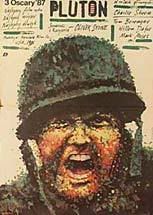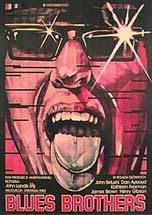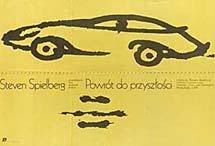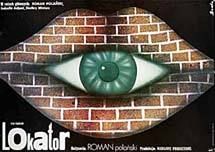
Polski Governator circa 1984
I actually had this idea myself, when I was frequenting the gym. Why are those treadmills and ski machines plugged in, drawing power? Why not reverse the flow and let those hot young girls in their 20's pump their energy back into the grid? As one dirty old man said to the other, if we could bottle that heat, we'd be rich.
So on to the Polish movie posters.






Sampling of Polish movie poster art from the late 1960s to the 1980s. From L-R top to bottom: Apocalypse Now, Platoon, In Cold Blood, Playtime, Alien, and The Phantom of Liberty.
I signed up as a volunteer with the American Cinematheque. I've been trying to get myself a little bit more involved in community affairs. Being a lousy manager of my own time often makes that extremely difficult. But the Cinematheque is one of those places that has exposed me to too much good stuff, and I owe something, however small, in exchange for all the great films I've learned about from their programming staff. So this month I searched the internet for movie posters to upload to fandango.com, to represent the films that are programmed in August. Found some cool old stuff for the Roger Corman retrospective, and old Elvis movie poster art is fun to look at it.
One of the great resources on the net for old movie poster art is posteritati.com. They specialize in film posters for collectors and have a bunch of posters for foreign films and foreign posters of American films. While browsing, I began to notice that almost all movie posters from Poland resisted the typical Hollywood marketing strategies that have been inherited in most other parts of the world. Polish movie posters, first of all, are almost always painted artwork, rather than photographic art from special photo shoots. Also, in concept, they do not strain themselves to "sell the star," by showing his stupid face. Instead, they draw their concept from the theme of the film, resulting in great expressionistic (or impressionistic?) subjective variations on the content of the movie.

 I have no idea how many Polish artists were active in the film advertising industry during its peak, or during the duration represented by posteritati's collection. But the art seems highly individual, as though there were no agency art director, no creative meetings, no client on the phone to dumb down the concept or request that it look more like the poster of last year's Oscar winner. These are designs where the painter seems to have had full control.
I have no idea how many Polish artists were active in the film advertising industry during its peak, or during the duration represented by posteritati's collection. But the art seems highly individual, as though there were no agency art director, no creative meetings, no client on the phone to dumb down the concept or request that it look more like the poster of last year's Oscar winner. These are designs where the painter seems to have had full control. It is interesting to see how they interpreted huge Hollywood blockbusters, movies that were marketed here with bright colors, big stars' faces, bold letters. The Polish art is totally indifferent to the salary of the actor who was in the movie, or the box office draw of the name "Spielberg." In the case of Back to the Future, it's as if the artist knew the movie was a pointless piece of shit and could not be bothered to make any unreasonable fuss over it.

 In more than one instance, looking at the Polish movie art for Hollywood films makes me curious to see what a Polish version of those same films would have been like. Of course, with films that have interesting thematic content, the artist grabs hold of it and produces a bold, effective design that often trumps the design from any other country. What's cool about posteritati's search engine is that you can search by film title or just by country, so after pulling a huge list of Polish posters, you can select one title and compare it to other art from around the world. This is exactly how I discovered that there was a consistent style to the art from Poland. If I knew more about art and painting, maybe I could use vocabulary to describe it more effectively or understand its relationship to the rest of Polish or Eastern European art. But as it is, I'm just a film buff who finds it extraordinary, and if I had the disposable wealth, and the mind to spend it on a collection of stuff, I would doubtless be buying Polish movie art.
In more than one instance, looking at the Polish movie art for Hollywood films makes me curious to see what a Polish version of those same films would have been like. Of course, with films that have interesting thematic content, the artist grabs hold of it and produces a bold, effective design that often trumps the design from any other country. What's cool about posteritati's search engine is that you can search by film title or just by country, so after pulling a huge list of Polish posters, you can select one title and compare it to other art from around the world. This is exactly how I discovered that there was a consistent style to the art from Poland. If I knew more about art and painting, maybe I could use vocabulary to describe it more effectively or understand its relationship to the rest of Polish or Eastern European art. But as it is, I'm just a film buff who finds it extraordinary, and if I had the disposable wealth, and the mind to spend it on a collection of stuff, I would doubtless be buying Polish movie art. 

Great Polish art for a great Polish film director. Polanski's Rosemary's Baby and The Tenant.
Go to posteritati's search engine and select POLISH from the POSTER NATIONALITY drop-down menu.
While you're at it, why not go to the Cinematheque's calendar and see what cool movies are showing this month?

